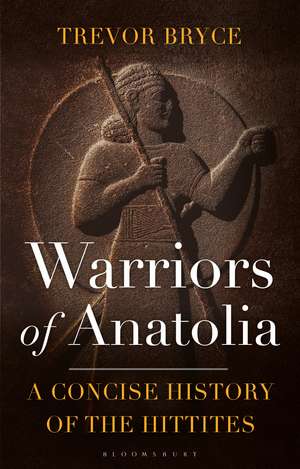Warriors of Anatolia: A Concise History of the Hittites
Autor Trevor Bryceen Limba Engleză Paperback – 16 noi 2022
| Toate formatele și edițiile | Preț | Express |
|---|---|---|
| Paperback (1) | 105.89 lei 3-5 săpt. | +17.80 lei 4-10 zile |
| Bloomsbury Publishing – 16 noi 2022 | 105.89 lei 3-5 săpt. | +17.80 lei 4-10 zile |
| Hardback (1) | 176.06 lei 3-5 săpt. | |
| Taylor & Francis Ltd (Sales) – 17 oct 2019 | 176.06 lei 3-5 săpt. |
Preț: 105.89 lei
Preț vechi: 115.28 lei
-8% Nou
Puncte Express: 159
Preț estimativ în valută:
20.26€ • 21.16$ • 16.73£
20.26€ • 21.16$ • 16.73£
Carte disponibilă
Livrare economică 25 martie-08 aprilie
Livrare express 08-14 martie pentru 27.79 lei
Preluare comenzi: 021 569.72.76
Specificații
ISBN-13: 9781350348851
ISBN-10: 1350348856
Pagini: 304
Ilustrații: 40 bw illus
Dimensiuni: 138 x 216 x 25 mm
Greutate: 0.2 kg
Editura: Bloomsbury Publishing
Colecția Bloomsbury Academic
Locul publicării:London, United Kingdom
ISBN-10: 1350348856
Pagini: 304
Ilustrații: 40 bw illus
Dimensiuni: 138 x 216 x 25 mm
Greutate: 0.2 kg
Editura: Bloomsbury Publishing
Colecția Bloomsbury Academic
Locul publicării:London, United Kingdom
Caracteristici
Weaves famous historical episodes such as the Battle of Kadesh against Ramses into a narrative that spans a much greater evaluation of the Hittites
Notă biografică
Trevor Bryce is Honorary Professor in Classics and Ancient History at the University of Queensland, Australia, and Emeritus Professor of Classics and Ancient History at the University of New England, Armidale, New South Wales, Australia. His many books include Life and Society in the Hittite World (2002), The Kingdom of the Hittites (new edition, 2005), The World of the Neo-Hittite Kingdoms: A Political and Military History (2012), Letters of the Great Kings of the Ancient Near East: The Royal Correspondence of the Late Bronze Age (2014), Ancient Syria: A Three Thousand-Year History (2014) and Babylonia: A Very Short Introduction (2016).
Cuprins
List of Maps and FiguresAcknowledgements Introduction Chapter 1: Rediscovering a Lost World Chapter 2: How Do The Hittites Tell Us About Themselves? Chapter 3: The Dawn of the Hittite Era Chapter 4: The Legacy of an Ailing King Chapter 5: 'Now Bloodshed Has Become Common' Chapter 6: The Setting for an Empire Chapter 7: Building an Empire Chapter 8: Lion or Pussycat? Chapter 9: From Near Extinction to the Threshold of International Supremacy Chapter 10: The Greatest Kingdom of Them All Chapter 11: Intermediaries of the Gods: The Great Kings of Hatti Chapter 12: King by Default Chapter 13: Health, Hygiene and Healing Chapter 14: Justice and the Commoner Chapter 15: No Sex Please, We're Hittite Chapter 16: Women, Marriage and Slavery Chapter 17: War with Egypt Chapter 18: All the King's Horses and All the King's Men Chapter 19: The Man Who Would Be King Chapter 20: Partners in Power: The Great Queens of Hatti Chapter 21: City of Temples and Bureaucrats: The Royal Capital Chapter 22: An Elite Fraternity: the Club of Royal Brothers Chapter 23: The Empire's Struggle for Survival Chapter 24: Hatti's Divine Overlords Chapter 25: Death of an Empire Appendix 1: Rulers of HattiAppendix 2: Outline of Main Events in Hittite History NotesSelect BibliographyIndex
Recenzii
Provides a thorough history of the Hittite kingdom, allowing readers to further understand the commonly hidden civilization of the ancient Near East.
Trevor Bryce has devoted his scholarly career to reconstructing the civilization of the Hittites of pre-Classical Turkey. In this book he draws on this experience to present an accessible overview of the history and culture of this fascinating ancient people. When the available evidence is scanty or unclear, he invites the reader to consider his or her own solution to historical quandaries.
Trevor Bryce has devoted his scholarly career to reconstructing the civilization of the Hittites of pre-Classical Turkey. In this book he draws on this experience to present an accessible overview of the history and culture of this fascinating ancient people. When the available evidence is scanty or unclear, he invites the reader to consider his or her own solution to historical quandaries.
